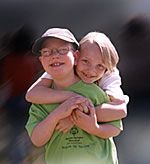Principal investigator: Mary L. Hediger, Ph.D.
Upstate KIDS (hereafter referred to as “the Study”) aims to determine whether infertility treatments, such as ovulation-stimulating medications and various assisted reproductive technologies (ART), adversely affect the growth, motor, and social development of children from birth through age three years, or if these technologies are associated with differences in the timing or rates of infant and child development, including motor and social development, the development of major and, especially, minor neuro-developmental impairments, and with physical growth patterns (e.g., length, weight, head circumference) and proportionality (weight-for-length). Major impairments of interest include cerebral palsy, intellectual disabilities, blindness, deafness, and multiple impairments based upon a diagnosis by a health professional (e.g., physician, audiologist). Minor impairments include deficits in motor skills, language skills, perception, vision, hearing, and cognition based upon standardized psychosocial or developmental screening assessment tools for infants and children at appropriate chronologic or gestation-corrected ages.
A secondary, but equally important, objective of the Study is to test the American Academy of Pediatrics (AAP) developmental surveillance and screening algorithm using the Ages & Stages Questionnaires, a parent-report developmental screening tool, at 4, 8, 12, 18, 24, 30, and 36 months and the Modified Checklist for Autism in Toddlers at 18 and 24 months, to augment routine pediatric care and to develop models for identifying infants and children in need of developmental assessment, diagnosis, and early intervention. The Study will provide information to the State of New York Department of Health that will allow it to more effectively plan and implement the New York State Early Intervention Program (EIP) and, by extension, to inform other States’ programs nationally.
The Study, which represents a collaborative effort among the DESPR Epidemiology and Biostatistics & Bioinformatics Branches, the New York State Department of Health, and the University at Albany School of Public Health, will implement a matched-exposure cohort design by: (1) Identifying all infants who were born in New York State (exclusive of New York City) by two to three months of age whose records indicate that they were conceived following infertility treatment (based on information submitted at birth into the Perinatal Data System); (2) Recruiting to retain a total of 1,500 families whose child(ren) were conceived with infertility treatment (exposed) and 4,500 regionally-matched families whose child(ren) were not conceived with infertility treatment (unexposed); the Primary cohort will include all singletons and one twin randomly selected from a set, while the co-twins will comprise a separate Secondary cohort; a separate cohort of all higher-order multiples (triplets, quadruplets) will also be recruited and offered the screening; (3) Administering an initial and then annual maternal and infant questionnaire and having parents complete the Ages & Stages Questionnaire developmental screen at 4, 8, 12, 18, 24, 30, 36 months of chronologic or gestation-corrected age and the Modified Checklist for Autism in Toddlers at 18 and 24 months and referring children who do not pass the screen to the NYS EIP; (4) Acquiring residual blood samples (punches) from the Guthrie cards collected at birth by the NYS Newborn Screening Program for analysis of inflammatory and immune markers that may indicate an intrauterine infection and be predictive of later disease or delays in development; and (5) Linking the cohort to the NYS Congenital Malformations Registry, Cancer Registry, Newborn Screening Program, and the EIP, among others.
DESPR Collaborators
· Germaine M. Buck Louis, Ph.D., M.S.
· Ondine von Ehrenstein, Ph.D., M.P.H., MSc.
· Rajeshwari Sundaram, Ph.D.
· Ann Trumble, Ph.D.
Selected Publications
Buck GM, Schisterman EF, Dukic VM, & Schieve LA. (2005). Research hurdles complicating the analysis of infertility treatment on child health. Human Reproduction, 20(1):12-18. [Abstract]
Schieve LA, Rasmussen SA, Buck GM, Schendel DE, Reynolds M, & Wright V. (2004). Are children born after assisted reproductive technology at increased risk for adverse health outcomes? Obstetrics & Gynecology, 103:1154-1163. [Abstract]
Hediger ML, Overpeck MD, Ruan WJ, & Troendle JF. (2002). Birth weight and gestational age effects on motor and social development. Paediatric and Perinatal Epidemiology, 16:33-46. [Abstract]
